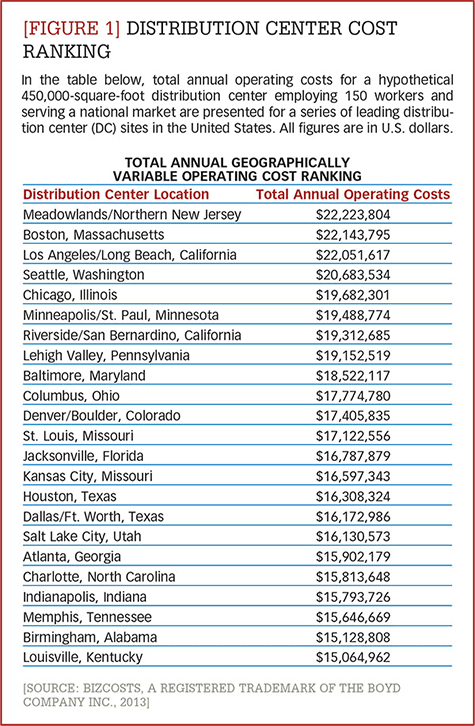Five trends to watch

Picking a location for a warehouse or distribution center (DC) is not a decision to be taken lightly. If a company makes the wrong choice, it will mean increased supply chain costs and inefficiencies for years to come. To avoid this mistake, companies need to be aware of the macro trends brewing on the horizon that could affect a warehouse's future costs or efficiency level.
During our firm's site selection engagements, we consult with a wide range of corporate managers who have input into the many quantitative and qualitative factors that go into location decisions for a new DC or warehousing operation. These include managers in traffic, facilities, finance, logistics, information technology, human resources, legal, engineering, telecommunications, manufacturing, and community relations, among others. It's an eclectic group, and so are the topics of our conversations. Here are the five trends these managers are talking about most in their meetings with us.
1. PRIVATIZATION AND TOLLS
Privatization of highways and bridges is a hot topic now for many of our distribution center clients. In the past, most highway and bridge infrastructure projects were funded by revenues from the gas tax. However, these revenues have been declining for years amid a cutback in driving, a shift to more fuel-efficient cars, and slumping auto sales. Privatization is being pushed by the Obama administration as a way to fund more highway and bridge infrastructure projects without raising fuel taxes. The likely result will be more toll roads, including portions of our interstate highway network.
What we are hearing from the trucking industry is that they hate the notion of a national tolling system. The full-truckload sector especially doubts its ability to recover the additional costs through some sort of surcharge that it would try to pass on to shippers. The parcel express business—with its focus on speed and efficiency—doesn't like it either. Trucking dispatchers are telling us that if the interstates are tolled, they will quickly shift routes to secondary highways, further congesting them and adding wear and tear to those roads.
The upshot of this trend would be more and more companies looking to locate their distribution centers in industrial areas close to rail/intermodal centers in order to balance out increased trucking costs.
2. COST CUTTING
While cost cutting has always been a big concern for warehousing managers, our nation's tepid economic recovery is making costs the "white hot" issue in corporate boardrooms today. At many of our DC clients, finance managers are explaining that the best way to improve the bottom line these days is on the cost side of the ledger, as there is little relief on the revenue side.

As a result, more companies are considering lower-cost locations for their distribution centers. Operating costs for a typical DC can vary greatly by geography, and a less-than-optimal location will result in higher costs, which could compromise the company's competitive position. The table in Figure 1 illustrates how significantly DC operating costs can vary within the United States. This BizCosts.com analysis conducted by The Boyd Company includes all major geographically variable operating-cost factors, such as wages, benefits, real estate, property taxes, utilities, and shipping. The table shows that annual costs for a hypothetical 450,000-square-foot DC employing 150 workers range from a high of $22.2 million in the Meadowlands in northern New Jersey to a low of $15 million in Louisville, Ky., a spread of $7.2 million, or a 32-percent differential.
3. THE NEW "LAST MILE" MARKET
The rise in e-commerce and omnichannel retailing, coupled with Amazon's ongoing quest for same-day delivery, is highlighting the importance of speed-to-market in today's economy. In San Francisco, Amazon is now testing its own delivery network for the final leg of a package's journey to consumers' doorsteps. The new service will give Amazon more control over shipping time and expenses. We expect the e-commerce giant and logistics innovator to roll out similar "last mile" services in major markets like Los Angeles, New York, and Chicago in the months ahead.
Amazon's "last mile" network will surely pose a challenge to express shipping companies like UPS, FedEx, and the U.S. Postal Service. We expect the Amazon experiment—buoyed by surging e-commerce and new ride- and trip-sharing apps like Uber—to open up a new distribution-channel market in major cities as well as create other new growth opportunities within the express shipment sector.
As a result of this trend, a number of new DC sites are emerging on our site selection radar screen. These locations put a premium on proximity to major, growing consumer markets; good transportation linkages; access to a work force with a wide range of blue- and white-collar skill sets; turnkey real estate sites with full utilities; and good cooperation with local municipal officials.
Probably one of the best examples is Robbinsville Township in central New Jersey, which is situated within minutes of Exit 7-A on the New Jersey Turnpike and about an hour from the megamarkets of both New York City and Philadelphia. In July 2014, Amazon opened its first DC in New Jersey in Robbinsville, a 1.2 million-square-foot fulfillment center that will employ some 1,400 workers. The company plans to use this fulfillment center to debut its much-anticipated same-day grocery delivery service, called AmazonFresh. We expect other DCs to be following Amazon to Robbinsville in the months ahead.
Nationally, other sites that we see riding this proximate-to-market trend include: Lehigh Valley, Pennsylvania; Towson, Md.; Dublin, Ohio; Fishers, Ind.; Jeffersonville, Ind.; South Fulton County, Ga.; Miramar, Fla.; Ruskin, Fla.; Sugar Land, Texas; Denton, Texas; San Marcos, Texas; Oak Brook, Ill.; Liberty, Mo.; Aurora, Colo.; Casa Grande, Ariz.; Tualatin, Ore.; Moreno Valley, Calif.; and Tracy, Calif.
4. THE NEED FOR MORE SKILLED WORKERS
The shortage of over-the-road truck drivers has been well documented in recent years. Manufacturing giants like GE, Caterpillar, and Siemens have also been very vocal about skill shortages in the United States being a major impediment to reshoring production jobs back to the U.S.
Not so well known to the general public is the growing shortage of workers in supply chain specialties like data analysis, robotics, engineering, and data security, to name just a few. While not as labor-intensive as call centers, our site selection projects in the DC sector are much more human resource-focused than ever before. HR managers need us to document that an area has a robust supply of technical and nontechnical workers not only at startup but also in the years ahead, especially if the DC is slated to provide additional value-added functions down the road. Our DC clients are increasingly interested in such labor market issues as the ability to hire ex-military, access to public transportation in order to tap inner-city labor pools, the availability of leading-edge skills in data security (a growing concern of our clients), and the tenor of labor-management relations. At the end of the day, labor is playing a greater role in distribution center site selection.
This is due in part to the breadth of jobs, from high-tech to low-tech, housed in today's distribution center, as well as to the rather low profile the logistics industry has assumed in the mindset of many college graduates. While the industry employs some 6 million workers and accounts for almost 9 percent of our nation's gross domestic product, its operations are mostly behind the scenes.
We expect the logistics industry to need to fill some 1.5 million jobs over the next five years. Compounding the industry's low profile among new college and tech school grads is the wave of retirements among the "baby boomer" generation that the industry is now facing. We are seeing a growing number of our DC clients turning to social media sites like LinkedIn and Facebook to search for new workers.
5. MANUFACTURING AT THE DC
In recent years, more and more value-added functions have started to be housed in distribution centers—whether they are blue-collar light assembly, white-collar office tasks, or customer service-related operations. We expect to see an emerging technology known as three-dimensional (3-D) printing, or "additive manufacturing," also being offered at distribution centers.
Three-dimensional printing is a process of creating a 3-D object from a digital file by laying down (or printing) successive layers of material. This new technology is expected to revolutionize production techniques, resulting in a significant proportion of manufacturing becoming localized and on-demand. The reliance on extended and costly supply chains would also be diminished. Our DC clients are telling us that the implications of 3-D printing could be enormous. Warehouse sizes and inventory levels could be reduced as 3-D printing leads to more real-time, custom manufacturing. For example, national parts warehouses would not need to be as large, because replacement parts could be downloaded, 3-D printed, and replaced within hours. Manufacturing reshoring from Asia would be hastened, thus reducing demands on the ocean shipping and aircargo industries.
Only a few years ago, 3-D printing seemed like something out of a science fiction movie, but major supply chain players in the auto, aerospace, and medical technology industries are already producing strong and light component parts using 3-D technology. As more industries adopt the technology, the impact on DC sizes, volumes, and mission will no doubt increase.
A MULTIDISCIPLINARY APPROACH
In order to respond effectively to the great variety of cost factors, human resource issues, and emerging technologies that are affecting site selection, corporate relocation teams need to be much more collegial and multidisciplined than ever before. Everybody—from traffic to legal—needs to have a say in today's location decisions. Additionally, companies may benefit from securing counsel from outside specialists. This may involve contracting with a corporate site selection firm like ours, or even outsourcing the entire logistics equation to a third-party logistics service provider.
This story first appeared in the Special Issue 2014 edition of CSCMP's Supply Chain Quarterly, a journal of thought leadership for the supply chain management profession and a sister publication to AGiLE Business Media's DC Velocity. Readers can obtain a subscription by joining the Council of Supply Chain Management Professionals (whose membership dues include the Quarterly's subscription fee). Subscriptions are also available to nonmembers for $34.95 (digital) or $89 a year (print). For more information, visit www.SupplyChainQuarterly.com.
Related Articles
Recent Articles by John H. Boyd
Copyright ©2024. All Rights ReservedDesign, CMS, Hosting & Web Development :: ePublishing